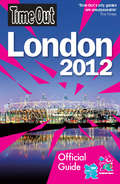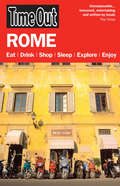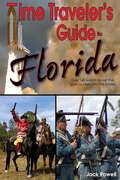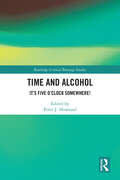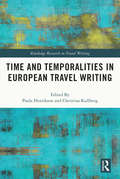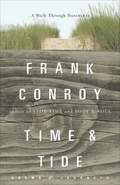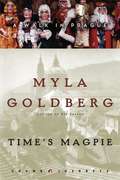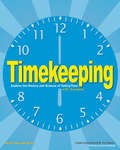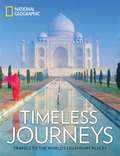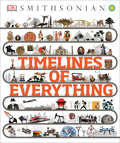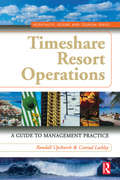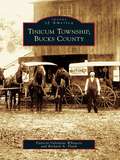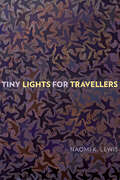- Table View
- List View
Time Out Miami and the Florida Keys
by Editors of Time OutThe sixth edition of Time Out Miami and the Florida Keys is your VIP pass to this A-list city. Time Out's intrepid team of insiders has combed its beaches, bars, restaurants and secret spots to create the definitive guide to the fabulous surreal life of Miami. All rumors of this city being heaven's waiting room will be dispelled as Miami's vibrant, youthful culture is exposed and explored. We will shed light-and not just a neon one on the evolution of what was once a sleepy beach town into one of the world's most glamorous spots.
Time Out New York
by Editors of Time OutNow in its 20th edition, Time Out New York provides the inside track on the Big Apple in an exhaustive guide with illuminating features and hundreds of independent unbiased venue reviews covering everything from iconic skyscrapers to buzzing neighborhoods. The guide offers an exhaustive overview of everything the city has to offer in terms of tourist attractions, eating and drinking, shopping, clubs and the sights - everything from pizza and bagels to shopping green. Comprehensive coverage of the city's incomparable arts and culture scene makes this an invaluable sourcebook for tourists and natives alike. An extensive month-by-month calendar of events is included. Escapes and excursions within relatively easy reach for day or overnight trips are also included.
Time Out Official Guide to London 2012
by Editors of Time OutThe official London 2012 Olympic Games and Paralympic Games licensee for travel and tourism guides, Time Out has produced a 2012 edition of the London city guide that is the essential tool to help visitors plan where to go, how to get involved in the games, and what to do during the rest of their stay in London. The 20th edition helps visitors to navigate the 2,000-year-old city from the handful of musts to the thousands of eccentricities and particularities that give London its real flavor. The sheer size of London can make it a daunting place to explore, making this guide even more valuable to help with the navigation.
Time Out Paris
by Editors of Time OutTime Out's resident team helps you get the best from the fascinating French capital in this annual guide. Along with detailed coverage of the Louvre, the Eiffel Tower and all the major attractions, Time Out Paris gives you the inside track on local culture, with illuminating features and independent reviews throwing the spotlight on everything from ancient street-corner cafés to vital new nightclubs.The 20th edition of Time Out Paris, written by a resident team of journalists, will help you get through the maze of tiny streets and the seemingly endless range of choices.
Time Out Rome
by Editors of Time OutWritten by local experts, Time Out Rome provides extensive coverage of the major sights - and then goes much further. Featuring everything from born-again trattorie to the burgeoning apertif trend, it offers visitors the chance to experience the Eternal City as the Romans do. History in Rome is not confined to museums, basilicas and galleries - it tumbles out everywhere. And though the city is reassuringly compact, this does not stop the cultural onslaught from being utterly bewildering and exhausting. While some travelers may have to face the fact that they probably won't see everything, it is also important not to shut oneself up inside all day looking at collections and sites or you will miss all that the outdoor scene has to offer. Time Out Rome helps travelers navigate through the cobblestone streets, so that they can eat, drink and shop like the natives. Suggested side trips out of town are also explored.
Time Out Venice
by Editors of Time OutVenice conjures images of gondolas drifting along misty canals and pigeon-feeding visitors dwarfed by the splendor of St. Mark's. For tourists seeking these typical Venetian icons, this magical city will never disappoint. But for a more rounded experience, the longtime residents and experts who have contributed to Time Out Venice take readers down backstreets and into campi and calli where few tourists tread: to hidden churches with hidden artworks; to architectural and sculptural gems in concealed courtyards; and to districts where the everyday life of Venice goes on in time-honored, washing-festooned, market-haggling fashion. Included is a wealth of practical information on escaping the menu turistico to discover authentic eateries; hiring a gondola and coping with acqua alta; finding budget digs in a city of haute hotels; and traveling beyond the Venetian lagoon to the magnificent cities - Padua, Verona, Vicenza, Treviso - and countryside of the mainland Veneto region.
Time Pieces: A Dublin Memoir
by John BanvilleFrom the internationally acclaimed and Man Booker Prize-winning author of The Sea and the Benjamin Black mysteries--a vividly evocative memoir that unfolds around the author's recollections, experience, and imaginings of Dublin. As much about the life of the city as it is about a life lived, sometimes, in the city, John Banville's "quasi-memoir" is as layered, emotionally rich, witty, and unexpected as any of his novels. Born and bred in a small town a train ride away from Dublin, Banville saw the city as a place of enchantment when he was a child, a birthday treat, the place where his beloved, eccentric aunt lived. And though, when he came of age and took up residence there, and the city became a frequent backdrop for his dissatisfactions (not playing an identifiable role in his work until the Quirke mystery series, penned as Benjamin Black), it remained in some part of his memory as fascinating as it had been to his seven-year-old self. And as he guides us around the city, delighting in its cultural, architectural, political, and social history, he interweaves the memories that are attached to particular places and moments. The result is both a wonderfully idiosyncratic tour of Dublin, and a tender yet powerful ode to a formative time and place for the artist as a young man.
Time Song: Journeys in Search of a Submerged Land
by Julia BlackburnJulia Blackburn has always collected things that hold stories about the past, especially the very distant past: mammoth bones, little shells that happen to be two million years old, a flint shaped as a weapon long ago. Shortly after her husband’s death, Blackburn became fascinated with Doggerland, the stretch of land that once connected Great Britain to Continental Europe but is now subsumed by the North Sea. She was driven to explore the lives of the people who lived there—studying its fossil record, as well as human artifacts that have been unearthed near the area.In Time Song, Blackburn brings us along on her journey to discover what Doggerland left behind, introducing us to the paleontologists, archaeologists, fishermen and fellow Doggerland enthusiasts she meets along the way. She sees the footprints of early humans fossilized in the soft mud of an estuary alongside the scattered pockmarks made by rain falling eight thousand years ago. She visits a cave where the remnants of a Neanderthal meal have turned to stone. In Denmark she sits beside Tollund Man, who seems to be about to wake from a dream, even though he had lain in a peat bog since the start of the Iron Age. As Doggerland begins to come into focus, what emerges is a profound meditation on time, a sense of infinity as going backward and an intimation of the immensity of everything that has already passed through its time on earth and disappeared.
Time Traveler's Guide to Florida
by Jack PowellFor those who believe that the best way to understand someone is to walk a mile in his or her shoes, Florida's rich history features those whose footwear ranged from Native American moccasins to astronauts' boots. And there are plenty of opportunities to actually walk in those shoes. You can join in all sorts of historical reenactments—in full costume if you like. You have the unique opportunity to relive a part of Florida's long and fascinating past. You can also travel forward into the future.A sample of the times you can visit: 12,000 B.C.: Stone Age and Primitive Arts Festival in Ochlockonee 1565: The Menendez Landing Event in St. Augustine1586: Drake's Raid on St. Augustine1650–1725: The Pirates of Fort Taylor in Key West1690s: Military Muster at Castillo San Luis in TallahasseeLate 1700s: The Living Village of Ah-Tah-Thi-Ki in the Big Cypress Seminole Reservation1835: The Dade Battle at Bushnell1864: The Battle of Olustee in Baker County1870: A Cane Boil at Morningside Farm in Gainesville1898: A Spanish-American War Event at Fernandina Beach1945: VE Day in Florida at The Villages2025: The Zero-G Flights at Cape Kennedyest. 2050: Jules Undersea Lodge inKey LargoThe day has arrived for this new kind of travelogue, which reveals not only places to visit but also time periods to experience. This is a book for today's explorers of place and space, past and future. This is The Time Traveler's Guide to Florida.
Time and Alcohol: It’s Five O’Clock Somewhere! (Routledge Critical Beverage Studies)
by Peter J. HowlandThe purposeful production, exchange, and consumption of alcohol, like all human endeavour, is always a matter of time and temporality – and ranges from the universality of Einsteinian space-time relativity through to species-specific nature times and the myriad of anthropocentric constructs of nature time and of social times/temporalities. Thus time and temporality is an integral variable in all alcohol production, exchange, and consumption, and is complemented by similarly rendered considerations of space/place, context, and contingent social relationships.The book draws on historical and ethnographic examples from Aotearoa New Zealand, China, France, India, Peru, Central Europe, and the United Kingdom to enhance our understandings of the dialogic matrices of time and temporality that are generated within, and which simultaneously generate various economic, social, political, religious, and moral modalities of alcohol in all their conceits and deceits.Time and Alcohol: It’s Five O’Clock Somewhere! will appeal to researchers and undergraduates from a wide range of disciplines, including sociology, history, anthropology, cultural studies, geography, marketing, and business studies.
Time and Temporalities in European Travel Writing (Routledge Research in Travel Writing)
by Christina Kullberg Paula HenriksonThis book is a collective effort to investigate and problematise notions of time and temporality in European travel writing from the late medieval period up to the late nineteenth century. It brings together nine researchers in European travel writing and covers a wide range of areas, travel genres, and languages, coherently integrated around the central theme of time and temporalities. Taken together, the contributions consider how temporal aspects evolve and change in regard to spatial, historical, and literary contexts. In a chapter-by-chapter account this volume thus offers various case studies that address the issue of temporality by showing, for example, how time is inscribed in landscape, how travellers’ encounters with other temporalities informed other disciplines; it interrogates the idea of "cultural temporalities" in regard to a tension between past and future, passivity and progression; and focuses on how time is entangled in identity construction proper to travelogues.
Time and Tide
by Frank ConroyFrank Conroy first visited Nantucket with a gang of college friends in 1955. They came on a whim, and for Conroy it was the beginning of a lifelong love affair with this "small, relaxed oasis in the ocean. " This book, part travel diary, part memoir, is a hauntingly evocative and personal journey through Nantucket: its sweeping dunes, rugged moors, remote beaches, secret fishing spots, and hidden forests and cranberry bogs. Admirers of Conroy's classic and acclaimed memoirStop-Timewill again delight in what James Atlas, writing in the New York Times, called his "genius for close observation. " InTime and Tide, Conroy recounts the island's history from the glory days of the whaling boom to the present, when tourism dominates. He vividly evokes the clash of cultures between the working class and the super-rich, with the fragile ecology of the island always in the balance. But most fascinating of all, he tells his own story--of playing jazz piano in the island's bars; of raising a barn in the early '60s with the help of a bunch of hippie carpenters; of leasing an old, failed bar with two island pals and turning it into the Roadhouse, a club "that was to be ours, the year-rounders, and to hell with the summer people. " There's a marvelous story of his first golf game, played on an ancient nine-hole course with two friends, a part-time sommelier and a builder from the South who invented the one-handed pepper mill. This is a book that revels in friendship, music, history, and the gorgeous landscape of a unique American place, and is a wonderful work by one of our greatest contemporary writers. From the Hardcover edition.
Time's Magpie: A Walk in Prague (Crown Journeys)
by Myla GoldbergSometimes a city can be like a bird. Just as the magpie is an inveterate collector, hoarding beautiful eclectic bits to line its nest, so Prague retains fragments from bygone regimes and centuries past to create a city of juxtaposition that is alternately exquisite and bizarre. Prague’s personality is expressed as much by its obvious beauty as by its overlooked details. This unforgettable place is brought to life by acclaimed author Myla Goldberg, a former Prague expat, whose first novel, Bee Season, captivated so many with its unique voice and exhilarating prose. Myla Goldberg lived in Prague in 1993, just as the process of Westernization was getting under way, the city straddling a past it wished to shed and a future it was eager to embrace. In 2003, she returned to see what the pursuit of capitalism had wrought and to observe the integral ways in which Prague’s character had endured. In Time’s Magpie, Goldberg explores a city where centuries-old buildings have become receptacles for Western values and a generation defined by the Communist regime coexists with a generation for whom Communism is a rapidly fading memory. Wander through the narrow alleyways and cobblestone streets to places most tourists never see—to a neighborhood eerily transformed by the devastating flood of 2002; to an anachronistic amusement park that is home to a discomfiting array of Technicolor confections; and to the cabinets of curiosity in the Strahov Monastery, where hidden among deceptively modest displays of butterfly specimens and ladies’ fans are creatures that defy the laws of taxidermy. This imaginative, individualistic journey will show you the odd and unique corners of a city often seeking to erase what its very stones will not allow it to forget.
Timekeeping
by Sam Carbaugh W Eric Martin Linda FormichelliTimekeeping: Explore the History and Science of Telling Time travels through the past and into the future to explore how humans have measured the passage of time. From ancient civilization's earliest calendars and shadow clocks to GPS and the atomic clocks of today, kids will track the evolution of timekeeping devices, meet the inventors of calendars and clocks, and learn interesting facts and trivia. Hands-on projects and activities include making a shadow clock, using a protractor to create a sundial, measuring time using water, and creating your own calendar. Kids will understand how civilization's vague abilities to track days and months has transformed over the centuries into a sophisticated ability to keep time to the millionth of a second.
Timeless Journeys: Travels to the World's Legendary Places
by National Geographic Ford CochranFrom Machu Picchu to the Pyramids of Giza and beyond, this travel-lover's delight takes readers on a breathtaking visual journey to the world's most historic wonderlands. Pack your bags for an extraordinary adventure with National Geographic to more than 50 places that have captivated our imaginations for centuries. In this visually stunning volume, the world's leading authority on cultural travel and history showcases bucket-list-ready destinations on every continent, from Easter Island's haunting stone moai to Kyoto's breathtaking temples. Vintage photographs from the National Geographic archives tell the backstory of the discovery and earliest visitors to places like Carthage, Pompeii, Victoria Falls, and more, while showstopping contemporary photographs bring them to life in exquisite detail. Full-spread features highlight lesser-known hidden sites, such as Pompeii's better-preserved sister city Herculaneum and the less-visited Maya city El Mirador in Guatemala’s jungle, offer readers extraordinary opportunities to deepen their travel experience and discover places where the past can truly come to life. With practical travel tips to help readers get started planning their own legendary journey, this is the perfect gift to keep—or share.
Timelines of Everything (DK Children's Timelines)
by DKExplore 13 billion years of history in the comfort of your own home! Journey through time and discover how some of the world&’s greatest events unfolded.From the Big Bang all the way through to the digital age, this incredible visual encyclopedia for children shows you just about everything that has ever happened in history.Witness history come alive as you travel through more than 130 stunning timelines. Packed with fantastic photographs and illustrations, along with informative text and fun facts. The history book covers the rise and fall of empires to ground-breaking scientific breakthroughs and inventions that changed our lives. This educational book is an imaginative way of illustrating world history for children age 8 and over. Throughout the pages, your child will get to meet the most bloodthirsty pirates of all time and discover what happened during the storming of the Bastille. It&’s a fantastic book for young readers with a natural curiosity about history around the world.Find your place in the world and understand where you fit in. Whether you want to discover the history of cinema, fashion, aviation, or espionage. There is something for everyone in this glorious guide through global history!The History of Everything… Ever!This fascinating reference book tells the story of a diverse range of subjects throughout history in an easily digested graphic format! After your kids dive into this book, you'll never hear them use the words "history" and "boring" in the same sentence again.Take a trip back in time! This history book covers the following eras: • Prehistory: Before 3000 BCE • The Ancient World: 3000 BCE – 500 CE • The Medieval World: 500 – 1450 • The Age of Exploration: 1450 – 1750 • The Age of Revolution: 1750 – 1914 • The Modern World: After 1914
Timelines of Everything: From Woolly Mammoths to World Wars (DK Children's Timelines)
by DKExplore 13 billion years of history in the comfort of your own home! Journey through time and discover how some of the world&’s greatest events unfolded.From the Big Bang all the way through to the digital age, this incredible visual encyclopedia for children shows you just about everything that has ever happened in history.Witness history come alive as you travel through more than 130 stunning timelines. Packed with fantastic photographs and illustrations, along with informative text and fun facts. The history book covers the rise and fall of empires to ground-breaking scientific breakthroughs and inventions that changed our lives. This educational book is an imaginative way of illustrating world history for children age 8 and over. Throughout the pages, your child will get to meet the most bloodthirsty pirates of all time and discover what happened during the storming of the Bastille. It&’s a fantastic book for young readers with a natural curiosity about history around the world.Find your place in the world and understand where you fit in. Whether you want to discover the history of cinema, fashion, aviation, or espionage. There is something for everyone in this glorious guide through global history!The History of Everything… Ever!This fascinating reference book tells the story of a diverse range of subjects throughout history in an easily digested graphic format! After your kids dive into this book, you'll never hear them use the words "history" and "boring" in the same sentence again.Take a trip back in time! This history book covers the following eras: • Prehistory: Before 3000 BCE • The Ancient World: 3000 BCE – 500 CE • The Medieval World: 500 – 1450 • The Age of Exploration: 1450 – 1750 • The Age of Revolution: 1750 – 1914 • The Modern World: After 1914
Timeshare Management: The Key Issues for Hospitality Managers
by Conrad Lashley Tammie Kaufman Lisa SchreierVacation ownership is becoming a mainstream travel product. Continued growth based on number of units sold and an increasing number of international brands has placed this segment in a very strong position. As the market continues to grow there is an increasing demand for clear and engaging sources of information on the key issues and components of vacation ownership, from both hospitality management students and the public.This book updates hospitality students in this vacation sector, provides the key background information, explanation of the growth, the components to vacation ownership management and an overview of opportunities in vacation ownership management. Timeshare Management provides the understanding of the financing, marketing, sales, management, and human resource issues surrounding the subject - vital to any hospitality and tourism student.
Timeshare Resort Operations (Hospitality, Leisure, And Tourism Ser.)
by Conrad Lashley Randall UpchurchThis book provides a complete overview of timeshare development and operation models. The authors take a comprehensive look at the present and future of this growing segment of the hospitality industry, including specialized approaches to marketing, human resources, service quality, finance, legal considerations and professional ethics. Timeshare, or vacation ownership, is a relatively recent leisure phenomenon. It emerged in the late 1950s as a way to secure extra capital resources to fund property expansion. Shareholders had the right to use these properties on a regular basis. Although arrangements have grown in complexity and variation, the model allows for customers to buy rights to use a property for a fixed time period each year. Timeshare arrangements have experienced rapid international growth particularly in the last fifteen to twenty years and are now an important vacation arrangement. Most of the world's major hotel and resort developers now operate timeshare properties. Firms like Marriott, Hilton, Hyatt, Disney and Ramada have brought a new formality and legitimacy to timeshare development and operation.
Tin Can Homestead: The Art of Airstream Living
by Natasha LawyerDIY enthusiasts, tiny house-lovers, and van-lifers will find inspiration and step-by-step instructions in Tin Can Homestead, the ultimate resource for living small in your own Airstream paradise.The Airstream trailer is the ultimate symbol of vintage wanderlust-and the classic touring vehicle's resurgent popularity has dovetailed with the tiny house movement, resonating with design-minded individuals looking to live small. Tin Can Homestead, based on the popular Instagram of the same name, is the ultimate resource for these would-be DIY-ers, and the perfect coffee-table addition for anyone looking for streamlined, modern lifestyle inspiration.Part practical how-to, part lushly illustrated design inspiration, Tin Can Homestead follows the story of one couple as they build themselves a new life in an old Airstream. Through personal stories and down-and-dirty checklists, this book guides readers through all stages of creating their own Airstream homes-from buying a trailer to plumbing and electrical work. With a hip, bohemian aesthetic and a fresh authorial voice, the authors pair their DIY knowledge with lifestyle advice-including décor, design, and entertaining-and abundant illustrations, from in-process photographs to hand-drawn illustrations.
Tinicum Township, Bucks County
by Richard A. Plank Patricia Valentine WhitacreTinicum Township remained just beyond civilization's limits as Europeans settled on farmland in lower parts of Bucks County early in the 18th century. Inhabited by Native Americans, the land was not appealing to Europeans. Tinicum was slowly settled by the English, Scotch-Irish, and Germans until early in the 20th century, when Eastern Europeans arrived, followed by artists and writers seeking refuge from city life. The hilly, rocky, and sometimes swampy topography that discouraged early settlement has continued to limit development of the rural areas between the six villages and hamlets of the township, so that early folks returning today would recognize the landscape and many of the homesteads they established here. Through vintage photographs, Tinicum Township, Bucks County celebrates the area's rich history.
Tiny Games for Work
by Hide SeekDesigned to give the maximum amount of fun for the minimum amount of rule-reading, Tiny Games for Work will let you find the perfect game for whatever situation you're in. All you need is this book, and the stuff that's around you. (Friends optional) Games for sticky notes and coffee grinds, games for dealing with customers and even games for working from home. Whether you're feeling creative or competitive, silly or energetic, we've got you covered.Games Include:Last Man StandingA game of competitive standing-up in meetings for 2 or more players.Do you have any meetings coming up?Countless esoteric etiquette rules govern when to stand and sit down in meetings, but this game follows one simple rule: you sit, you lose. Before your meeting, agree on who'll be playing. When you go in for the meeting, the last player to sit down wins. At the end of the meeting, why not play Last Man Sitting? You can figure out the rules. Next time, why not stand on one leg only?2002 Berlin Thunder SeasonA game for any number of bold e-mailers unafraid of creative metaphor. Do you have a computer with Internet access and work e-mails to send?Subject to the whims of Wikipedia's 'Random article' feature, you'll need to slip some unusual words or phrases into work e-mails. Go to Wikipedia and click on 'Random article'. Note and copy the full title of your fascinating factually-accurate [citation needed] article. You must now subtly slip this full title somewhere into the next work e-mail you send.Repeat until satisfied, or until questioned about your references to obscure byelaws and pop songs. If you want to keep score, count how many you can fit into an e-mail...Don't Draw the Short StrawA game for an uneven number of players. Do you have pens and paper, and an odd number of players?In this game, you'll be drawing straws. On paper. With pens or pencils. Draw the longest or the shortest straw and you're out - the happy medium straw is what it's all about.Give everyone a piece of paper and a pen. Now, everyone - secretly draw a straw. You want your straw to be the medium-sized straw. Has everyone finished? Amazing.REVEAL YOUR STRAWS! The people who drew the LONGEST and the SHORTEST straw are both eliminated. Now, repeat until only one player remains - our winner! All the drawings of straws are yours - a glorious prize!
Tiny Lights for Travellers (Wayfarer)
by Naomi K. LewisGovernor General’s Award Finalist: A “wry, moving” memoir of a woman retracing her grandfather’s escape from Amsterdam during the Holocaust (Alison Pick, Booker-nominated author of Between Gods).Why couldn’t I occupy the world as those model-looking women did, with their flowing hair, pulling their tiny bright suitcases as if to say, I just arrived from elsewhere, and I already belong here, and this sidewalk belongs to me?When her marriage suddenly ends, and a diary documenting her beloved Opa’s escape from the Nazi-occupied Netherlands in the summer of 1942 is discovered, Naomi Lewis decides to retrace his route to freedom. Travelling alone from Amsterdam to Lyon, she discovers family secrets and her own narrative as a second-generation Jewish Canadian. With vulnerability, humour, and wisdom, Lewis’s memoir of her journey, interspersed with excerpts from her grandfather’s diary, asks tough questions about her identity as a secular Jew, the accuracy of family stories, and the impact of the Holocaust on subsequent generations.
Tiny New York: The Smallest Things in the Biggest City
by Suzi SiegelBecause in a giant city, sometimes the smallest things get overlooked.Tiny New York peeks into the city&’s nooks and crannies to find the little things that tell the real New York story. Because in New York, Tiny isn&’t cute. It&’s tough. Tiny doesn&’t wait for handouts. It hustles. Tiny isn&’t insignificant. It&’s precise. Tiny isn&’t a jack-of-all-trades. It&’s the master of one.There are plenty of books about New York City. But there has never been a book about the smallest things in the biggest city.
Tiny Pieces of Us: The new emotional and heartwarming page-turner you need to read in 2020!
by Nicky Pellegrino'Heartrending and compelling' JOJO MOYES on Recipe for LifeMy heart is less than 1% of my body, it weighs hardly anything; it is only a tiny piece of me, yet it is the part everyone finds most interesting.Vivi Palmer knows what it's like to live life carefully. Born with a heart defect, she was given a second chance after a transplant, but has never quite dared to make the most of it. Until she comes face-to-face with her donor's mother, Grace, who wants something in return for Vivi's second-hand heart: her help to find all the other people who have tiny pieces of her son.Reluctantly drawn into Grace's mission, Vivi's journalist training takes over as one by one she tracks down a small group of strangers. As their lives intertwine Vivi finds herself with a new kind of family, and by finding out more about all the pieces that make up the many parts of her, Vivi might just discover a whole new world waiting for her...Readers are loving Tiny Pieces of Us:'Warning! You will need tissues. Absolutely beautiful''Emotional and thought-provoking''Couldn't put it down!''Made me laugh, made me cry''Full of sensitivity, warmth and love'


